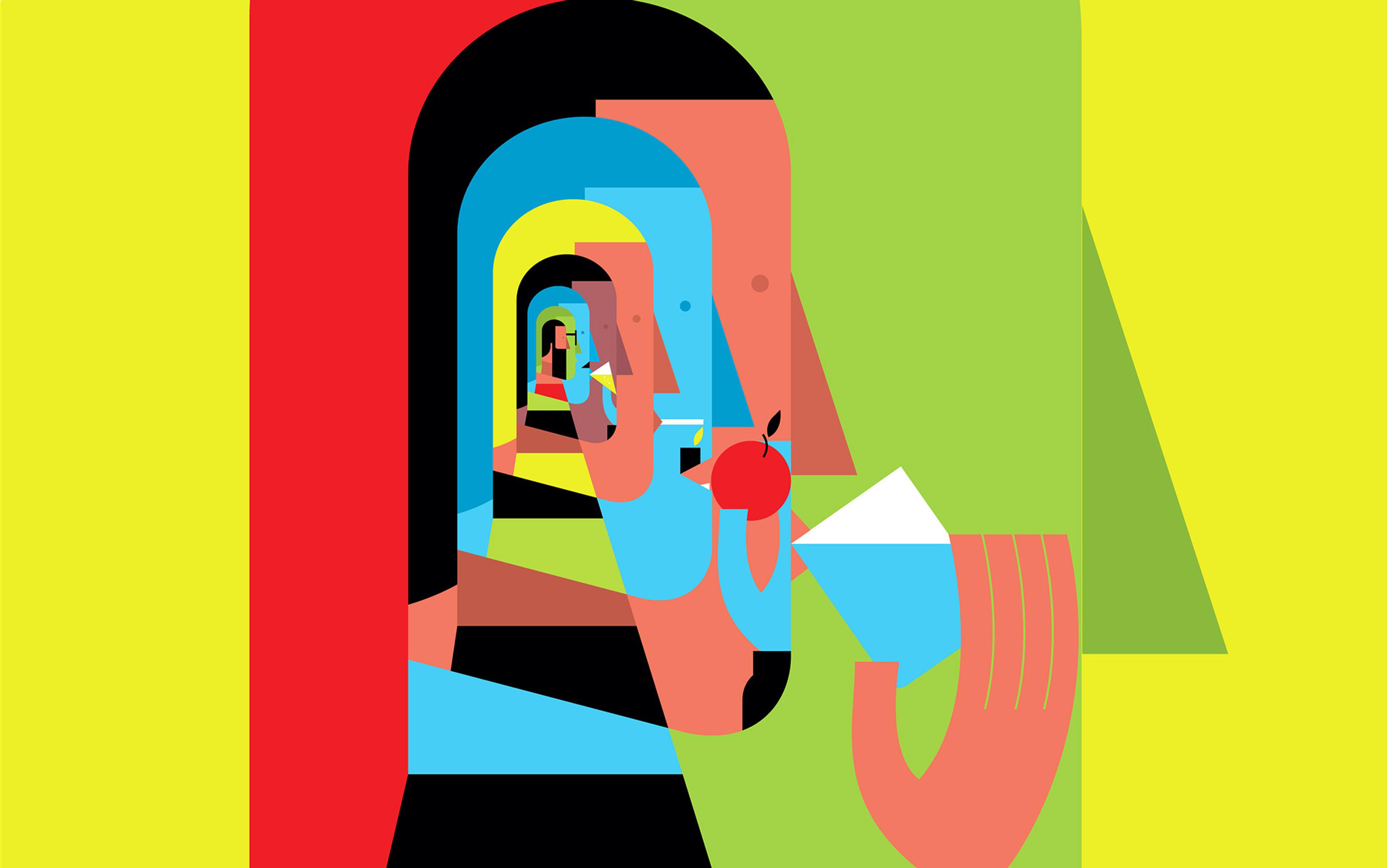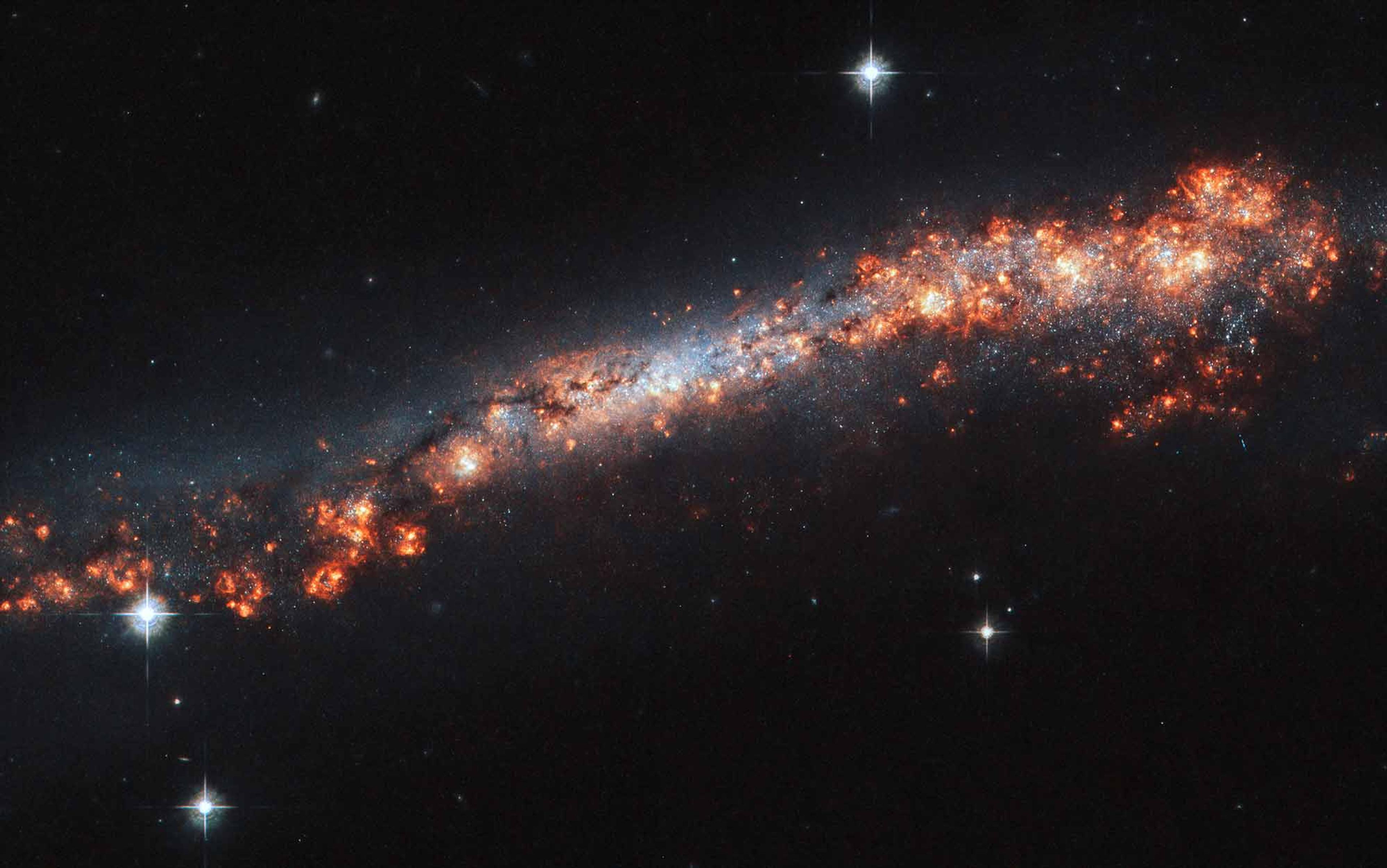Recently, I was caught on the horns of a dilemma. I had a decision to make and, either way, I knew my life would follow a different track. On one path, I accept a job offer: it’s an incredible opportunity, but means relocating hundreds of miles away, with no social network. On the other, I stay in Oxford where I’d lived for a decade: less adventure, but close to my friends and family. Both options had upsides and downsides, so I wished that I could take the job and turn it down, somehow living each life in parallel.
Well… there was potentially a way to make this happen. I could have my cake and eat it too.
This will seem odd at first, but bear with me. There are smartphone apps that can help you decide between two options by harnessing the unpredictable quirks of quantum mechanics. But this is no ordinary coin toss, where randomness decides your fate. Instead, it guarantees that both choices become realities.
You open the app and request a measurement of a photon, which forces it to occupy a binary state, such as ‘spin up’ or ‘spin down’. In my case, ‘spin up’ meant accept the job and ‘spin down’ meant decline. You will see only one result but, in theory, another you will see the opposite, in a different universe. From that moment, two versions of you co-exist, living in parallel.
It’s inspired by the ‘Many-Worlds’ interpretation of quantum mechanics, first proposed by the physicist Hugh Everett III in his doctoral dissertation in the 1950s. He argued that our Universe branches into multiple worlds every time a quantum event takes place – and thousands happen every second. While this idea seems fantastical, a growing number of scientists and philosophers think this is how our world really works. In fact, if the Many-Worlds interpretation of quantum mechanics is true, then the splitting of worlds is not only possible, it is ubiquitous.
As a philosopher of religion, I am interested in how this mind-boggling scientific theory might force us to reexamine even our most deeply held beliefs. In fact, I believe that the Many-Worlds interpretation of quantum mechanics encourages us to radically reconceptualise our understanding of ourselves. Perhaps I am not a single, unique, enduring subject. Perhaps I am actually like a branching tree, or a splitting amoeba, with many almost identical copies living slightly different lives across a vast and ever-growing multiverse. I also believe that this picture encourages us to rethink our ideas about moral responsibility, and what religion tells us about God – maybe, even, abandon the traditional idea of God altogether.
The year 2025 will mark the centenary of Werner Heisenberg’s development of matrix mechanics, the first formalisation of quantum mechanics into a coherent physical theory. You might think that after 100 years and such staggering success, there would be consensus about how to interpret what the theory means for the wider world. You’d be wrong.
For much of the 20th century, the so-called Copenhagen interpretation of Heisenberg, Niels Bohr and others ruled the day. In recent years, however, a growing number of people are questioning it, dubbing it the ‘shut up and calculate’ approach because of its unwillingness to ask deeper questions about what all this is supposed to mean. The appetite for something more metaphysically satisfying is growing, and those working in this area are rising to the challenge.
The Everett, or Many-Worlds, interpretation is now a powerful contender. It builds on the fact that quantum objects exist in superpositions: in all possible states at once. As Erwin Schrödinger observed in the 1930s, hypothetically this could mean you could have a cat in a box that is alive and dead simultaneously. This seems impossible – and, for Schrödinger himself, that was the point. But the Many-Worlds interpretation solves the problem by claiming that the cat is not both alive and dead; rather, it involves multiple worlds, some of which contain alive cats and some of which contain dead cats. In other words, each possible outcome actually happens. Whichever state of affairs we observe when we open the box indicates which world we are in, but the other worlds are equally real.
That’s all very well, but what should we make of this in day-to-day experience? Here physics falls short. For starters, if we live in a universe where there are multiple versions of you, thorny questions are raised about whether these versions of you can be considered the exact same person. For most people, the idea that they continue to exist from birth to death is an obvious fact that requires no further contemplation, but philosophers have spilled much ink trying to define what makes ‘you’ persist through time. Some have argued it’s about psychological continuity – you have the same mind and memories as your past self. Others propose that it’s about owning the same body. Many religious believers, meanwhile, would point to the existence of a single, indivisible soul.
If you can theoretically survive teleportation, why should an extra version of you mean you have died?
A few decades ago, the philosopher Derek Parfit stress-tested these assumptions by exploring the concept of ‘fission’ in thought experiments, inspired by cell division. He argued that identity is a one-one relation, meaning that you cannot be identical with multiple people. This means that if you were to split into two identical copies, then you would cease to exist.
It might be hard to imagine why at first. If you were destroyed but a copy of your body and mind appeared in their place a fraction of a second later, you probably wouldn’t notice the difference. From your internal perspective and from the perspective of those who know and love you, you would continue to exist. In fact, it is this kind of disappearing and reappearing that would be involved in teleportation, if that were ever to become possible. So if you can theoretically survive teleportation, why should an extra version of you appearing mean that you have died? Surely there being more of you can’t mean that you have ceased to exist altogether?
When tackling this problem, a philosopher might first reach for the principle of ‘the identity of indiscernibles’. According to this principle, if two objects are in fact one and the same identical object, they must have all the same properties. For example, the morning star and the evening star are identical because both names refer to the same thing: the planet Venus.
Another principle is ‘the transitivity of numerical identity’. This picks up on something intuitively obvious – the relation of ‘being identical with’ transfers. If the current British king is identical with Elizabeth II’s eldest son, and Elizabeth II’s eldest son is identical with Charles Mountbatten-Windsor, then the current king is identical with Charles Mountbatten-Windsor.
Let’s apply these principles to Parfit’s fission. Suppose someone, let’s call her Alice, splits into two identical copies (we’ll call them Lefty and Righty). Is the pre-fission person, Alice, identical with Lefty, Righty, both, or neither? If both Lefty and Righty share Alice’s memories and feel like Alice from the inside, then they have psychological continuity with Alice. According to this way of understanding identity, they are both identical with Alice. But the problem is, they are not identical with each other. They occupy different spatial locations, have distinct streams of consciousness, and so by any measure they are different persons.
To return to our above principles, Lefty and Righty are discernible, so they are not identical. That means that Alice cannot be identical to either of them without violating the transitivity of identity principle. If Alice is not identical with either Lefty or Righty, and Lefty and Righty are all that remain after Alice has split, then Alice does not exist anymore. It is because of this that some philosophers believe that fission means death.
This all might sound very abstract and hypothetical, but if the Many-Worlds interpretation is correct, then Parfit’s idea of fission was part of reality long before philosophers existed to contemplate it. As the physicist Sean Carroll put it in his book Something Deeply Hidden (2019): ‘the life-span of a person should be thought of as a branching tree, with multiple individuals at any one time, rather than as a single trajectory – much like a splitting amoeba.’ What are we to make of the idea that the human person ought to be thought of like a phylogenetic tree, a set of descendants branching off from each other forever but sharing a common ancestor? The philosophical implications for our understanding of personal identity are mind-boggling.
An additional thorny problem raised by a universe of many worlds is that of moral responsibility. Most ordinary people’s moral intuitions about right action – whether some action was freely made, whether it accords with shared moral principles, and whether a person can be held responsible for it – were formed under the assumption that we live in a singular universe. But if Everett was right and we are living in a quantum multiverse, we might need a rethink.
When we say an individual is morally responsible for a crime or a kindness, for instance, we are saying that they possess capacities such as volition, control over their actions and awareness of consequences. The individual deserves blame or condemnation if what they have done is bad, and praise and admiration if what they have done is good.
Whether we realise it or not, our judgments about moral responsibility rely upon certain conditions. These are:
- the person held responsible is the exact same person as the person who performed the action; and
- the person performed the action freely.
To understand why these conditions matter, consider two versions of a single event: my elderly grandmother is knocked to the floor and injures herself at a family birthday party. In one version, I’ve slipped on a banana skin and fallen into her. In the other, I’ve deliberately pushed her in rage because she ate the last piece of birthday cake.
Across the multiverse, everything that can happen does happen; each branch is inevitable
In each case, I am causally responsible for my grandmother’s injuries. Only in the second case, however, am I morally responsible. If it’s an accident, I lack volition, or free and deliberate action in accordance with my will.
The problem is, Many-Worlds is a deterministic theory – and determinism is considered by many, though not all, philosophers to be incompatible with genuine freedom. Across the multiverse, everything that can happen does happen; each branch is inevitable. If that’s the case, even if we feel like we have the freedom to choose what actions we take, this may in fact be an illusion. We wouldn’t think me morally responsible for pushing over my grandmother if someone held a gun to my head and threatened to kill me if I didn’t. Similarly, if all my actions are determined by physical forces outside my control – like the laws of quantum mechanics – then it seems pretty unjust to punish me for them.
Alongside freedom, personal identity is also essential to moral responsibility. I cannot be held responsible for something unless I am the one who does it, or the one who forces someone else to do it. If someone who looks very much like me, such as my identical twin, pushed over our grandmother, it would be deeply immoral to punish me just because I look identical to the true culprit. In order for the responsibility to be mine, the action must have been committed by me. Because of this, it is of the utmost importance to work out whether the other versions of me, including the past versions of me whom I seem to remember being, can be firmly established as being myself and not just people who look rather like me. If we cannot do this, then our ordinary notion of moral responsibility and all that comes with it – holding people accountable, punishing those who have done wrong, trying to uphold moral standards in society – slips through our fingers.
The Many-Worlds interpretation also raises conundrums for religious believers committed to the idea of an all-powerful creator. In particular, it threatens to amplify the ‘problem of evil’: the oldest and most frequently cited argument against the existence of an omniscient, omnipotent and benevolent god. In broad brushstrokes: if God is all-seeing, God should be aware of all the evil and suffering that occurs. If God is all-powerful, then God should be able to stop all evil and suffering. If God is all-loving and perfectly good, God should want to exercise these powers to end evil and prevent suffering. And yet we see suffering and pain all around us. The problem of evil exists whether we are living in a multiverse or not – but I believe the problem is far worse if Everett was right about how to interpret the quantum equations.
As we have already seen, the Many-Worlds interpretation claims that there are multiple versions of me, each of whom shares parts of my past but not my present, nor my future. Out of all these people, there must be at least one who is living the worst possible version of my life, and there will be countless more living very bad lives. In other words, there is much more suffering in the Everettian multiverse than there is in a singular universe. What’s more, suffering will be in each of our futures, even if we don’t know which future and which version of us will have to endure it.
When I present this problem to religious believers, many want to turn it on its head. While there is much more pain in Many-Worlds, they argue, there is a correspondingly greater amount of good. For every suffering version of me, there is at least one living the best version of my life, and many more living good ones. On balance, then, the distribution of goods and evils is not so different to the world described by non-Everettian physics, and the problem of evil is no greater than it was before. Perhaps belief in God is not in that much trouble after all.
A world that allows a child to suffer for the benefit of someone else is a world we should not want to live in
I think this response fails, and my reason is based upon a common distinction theologians make between two equally important descriptions of God. That is, the distinction between God as a provider of global goods on the one hand, and as a loving parent of individual persons on the other. God isn’t just supposed to be a powerful but largely absent creator who set the world into motion and then stepped back without caring how it unfolded. Fewer people would worship a detached, impersonal force who has no interest in the small, intimate details of ordinary human lives. God is also supposed to care deeply and personally about each and every creature. Their suffering matters. If religious believers did not think this, then prayer would be pointless and worship worthless.
God should want to stop the extra suffering of the many versions of me living terrible lives, even if it meant that there wouldn’t be a corresponding number of Emilys living happy lives. Why? Because joy and suffering are not morally equal. If you were forced to choose between curtailing the joy, pleasure or happiness of one person to stop some other person suffering, you know that stopping suffering must always take precedence. That’s why we punish violent sexual crimes – the pain and the violation of the victim is much more morally important than any predator’s pleasure.
One might see how a God could choose to design a universe that vastly increases the number of versions of each person who are able to enjoy virtuous, joyful and fulfilling lives. Yet as a parent who loves each individual creature, it seems inconceivable that God would create a reality in which at least one version of every single person is living the worst iteration possible of their life. In the oft-referenced words of Ivan Karamazov, a world that allows an innocent child to suffer greatly for the benefit of someone or something else is a world that we should not want to live in.
Even if we live in a singular universe, the problem of evil is the prevailing reason that I cannot accept that God exists. If there are many worlds, with untold suffering far beyond what I can imagine, then it only deepens my conviction.
So, if the Everettian multiverse is reality, we exist as continually branching selves like splitting amoeba, our ideas of morality are turned upside down, and there are compelling arguments for why there is no God overseeing it all.
We are also left with something of an identity crisis: it’s not even clear if we ‘survive’ from moment to moment, if branching is a kind of a death. How do I make sense of that personally? One solution I am currently exploring is the idea that who we are is determined by a narrative thread of our own weaving. On this view, who I am is no more nor less than my own internal self-conception, shaped by memory, desire, emotion, experience and embodiment. On this view, it does not matter whether there are copies of me or not, and I should not care which philosophical principles these copies might violate. All that matters is that who I am is decided by me – it is subjective, not objective.
What this means is that instead of human beings having a core essence – something like an eternal and indivisible soul – we are collections of stories told and retold by us and those who love us. We are rivers, ever fluid, whose banks are shaped by sediments of stories stored in our depths.
In the Everettian multiverse, we have an infinite number of futures laid out before us
The late philosopher Daniel Dennett held a similar view. According to him, the self is like a centre of gravity, a useful fiction that theoretical physicists and ordinary people alike construct to make sense of the world. For Dennett, all we have are evolving identities tied together by an autobiographical thread that is ever in flux. The self is an abstract construct; it does not really exist.
It would also mean that, if you are ever caught in a seemingly impossible dilemma, there is a way for you to have your cake and eat it too. I decided not to accept my job offer in this universe, but I like to think that another Emily did. In the many worlds of the Everettian multiverse, we have an infinite number of futures laid out before us. No more Sophie’s choice-type decisions need keep you up at night, instead you can flip a quantum coin and live both lives (even if you won’t ever know how the other future works out). Although we know that some of our futures contain suffering, perhaps we can take comfort in the idea that somewhere out there at least one version of us is living the best life possible.
Finally, it might encourage us to abandon religious ideas written in different historical contexts and shaped by different metaphysical understandings of the Universe. Perhaps there is no God. Instead of this leaving us with a cold and meaningless cosmos, I think it gives us radical autonomy to create our own systems of meaning. What matters, what is good and valuable, is up to us to decide.
Whatever solutions we eventually land on, what’s clear is that this radical and mind-bendingly weird interpretation of quantum mechanics raises big questions about ourselves, the Universe, and the existence of God. I, for one, can’t wait to see where the quantum physics takes us. Wherever we end up, it’ll be a wild ride.






